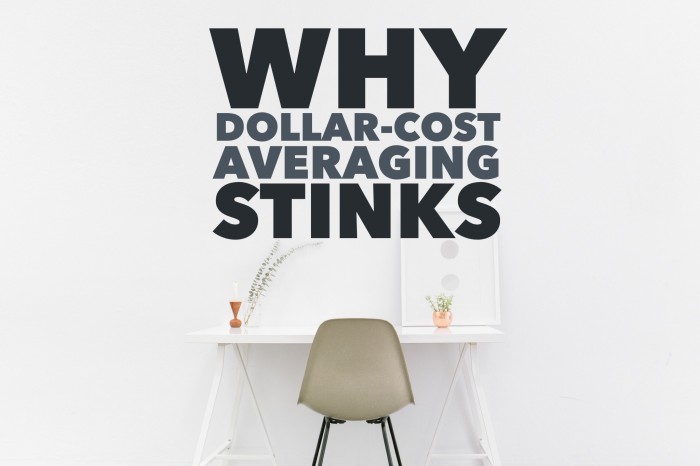
Conventional wisdom says that you should invest in the market in small bites.
This is called “dollar-cost averaging.”
Dollar-cost averaging is the philosophy of wading slowly into the market over time, rather than diving in.
If you have a large sum of money — through a bonus, commission, gift, sale of a house or car, etc. — the popular snippet of advice is that you should hold it in cash. Slowly invest small amounts.
It’s popular.
But it’s wrong.
Research suggests that if you have a lump-sum of cash, you should dive into the market headfirst.
The Background
Dollar-cost averaging supporters say that if you pour every dollar into the market at the same time, you might accidentally buy at the worst moment, when the price is peaking. If you buy stocks in small increments over time, though, you spread out your risk.
For example, a person with $5,000 who wants to invest in The XYZ Index Fund might:
Invest the entire $5,000 at a rate of $50/share.
– OR –
Invest $1000 on Jan 1 at $50/share
Invest $1000 on Feb 1 at $53/share
Invest $1000 on March 1 at $46/share
Invest $1000 on April 1 at $48/share
Invest $1000 on May 1 at $48/share
Average cost per share? $49 dollars. You’ll also own more shares. The same $1,000 will buy you more shares when prices are low and fewer when prices are high.
Conventional wisdom says that this strategy — easing into the market — is a smart way to invest.
The data says otherwise.
Dollar-Cost Averaging Research
In 1993, researchers from Dayton, Ohio imagined what would happen if they converted $120,000 from Treasury bills into an S&P 500 index fund.
They ran two scenarios: what happens if they invest the lump-sum on January 1, and what happens if they transition the money over the span of a year? They ran a historic analysis covering every year from 1926 to 1991.
The result?
The lump-sum strategy won two-thirds of the time.
“Based on historical evidence … the odds strongly favor investing the lump sum immediately.”
The following year, another research duo ran a similar comparison. They concluded that dollar-cost averaging “is mean-variance inefficient compared with a lump-sum investment policy.”
That’s researcher-lingo for “throw your chips in the game.”
Around that same time, a different research team showed that there’s no statistical difference between dollar-cost averaging and throwing money into the market at random intervals.
A bevy of other studies followed. By December 2001, a research team threw their hands up and said: Fine, fine. Maybe lump-sum investing helps you gain more. But does dollar-cost averaging help you lose less?
In other words, is it a risk-mitigation technique rather than a growth technique?
They ran a study based on this question – and discovered that the answer is no.
“We find loss aversion still does not explain the existence of the dollar-cost averaging strategy.”
But Why?
What’s the problem with this strategy?
Two words: Opportunity cost.
You miss the opportunity for gains when most of your money is sitting in cash.
Over the span of a year, that missed opportunity is likely to cost you more.
You’ll be disproportionately overweight in cash or cash equivalents during the year that you’re easing into the market. And you’re at a huge disadvantage if your asset allocation is too far off-kilter.
Furthermore, there’s a low likelihood that you’ll happen to put your money in the market at the worst possible moment.
There’s some evidence that suggests that the market tends to move in spurts. Missing a few critical days of gains each year will create a disproportionate impact on your portfolio.
The Bottom Line
This warning against dollar-cost averaging applies only when you’re comparing it to a lump-sum investment.
If you’re averaging into the market as you get paid, then you’re simply investing money as you get it.
There’s no better alternative to that. You can’t invest money that you don’t have yet.
Plus, dollar-cost averaging your paychecks won’t throw your asset allocation askew.
But if you happen to have a cool stash of cash lying around – perhaps from a tax refund, bonus, commission, gift, or asset sale – don’t be afraid to toss it into the market immediately.